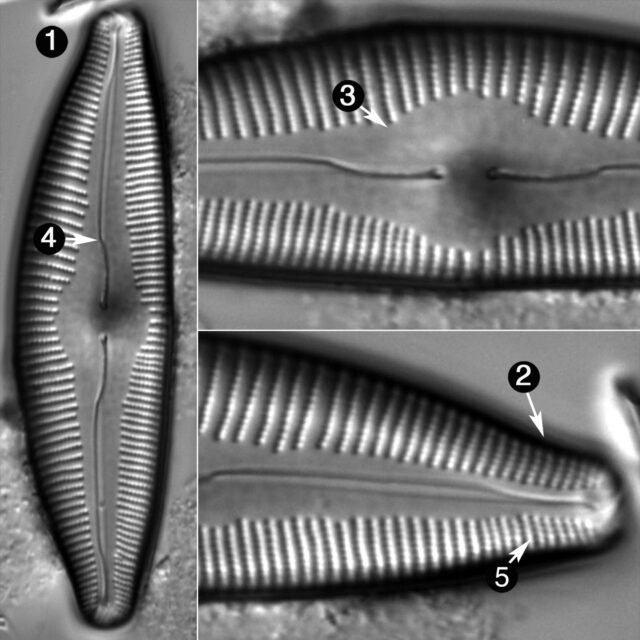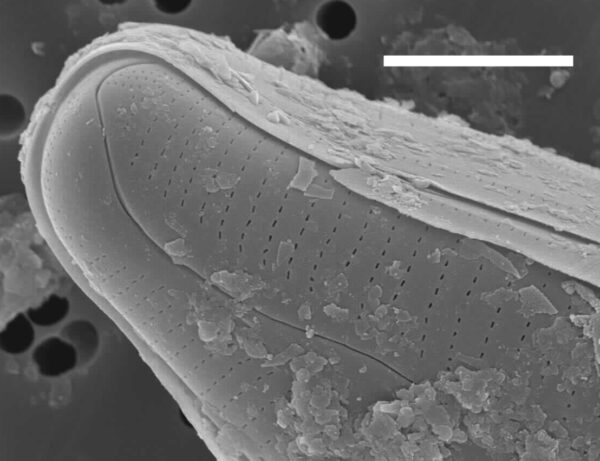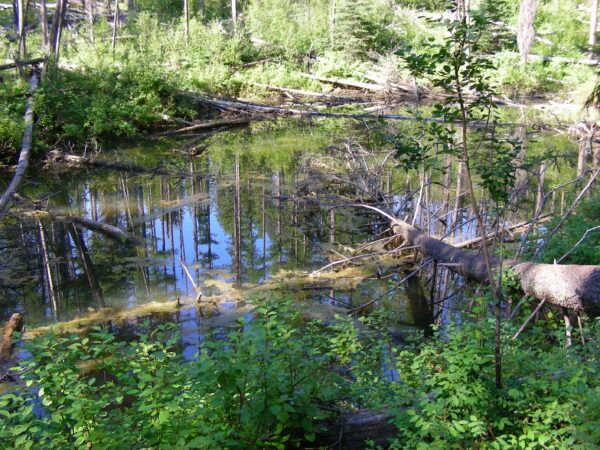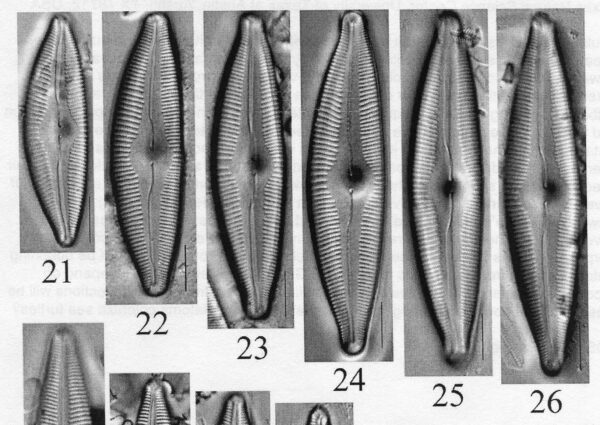Cymbopleura edlundii
-
Category
-
Length Range51-87 µm
-
Width Range14.3-17.9 µm
-
Striae in 10 µm9-13 at the valve center, 14-16 near the apices
-
ContributorLoren Bahls - Sep 2012
-
ReviewerSarah Spaulding - Aug 2013
Identification
Description
Valves are lanceolate with rounded subrostrate apices. Valves are distinctly dorsiventral in small specimens, slightly dorsiventral in larger specimens. Axial and central areas are very wide, 1/3 to 1/2 the valve width, together forming a lanceolate space with a tumid center somewhat offset to the ventral side of the valve. The raphe is distinctly lateral, becoming weakly reverse-lateral near the proximal and distal ends. Proximal raphe ends are offset to the ventral side and tipped with distinctly expanded central pores. Distal fissures are hooked towards the dorsal side. Striae are radiate throughout and more dense near the apices and on the ventral side. Areolae number 25-30 in 10 µm.
Autecology
Cymbopleura edlundii is known only from the type locality, a small pond in Glacier National Park, Montana, near the Canadian border. Water quality data for this pond are not available.
-
Size Range, µm3
-
Motility
-
Attachment
-
Habitat
-
Colony
-
Waterbody
- Learn more about this
Original Description
Valves lanceolate with rounded subrostrate apices, distinctly dorsiventral in small specimens, slightly dorsiventral in larger specimens. Valve length 51–87 μm; valve width 14.3–17.9 μm. Axial and central areas very wide, 1/3 to 1/2 valve width, together forming a lanceolate space with a tumid center somewhat offset towards the ventral margin. Raphe distinctly lateral, becoming weakly reverse-lateral near proximal and distal ends. Proximal raphe ends offset to the ventral side, tipped with distinctly expanded pores. Distal raphe ends hooked towards the dorsal side. Striae radiate throughout, 9–13 in 10 μm at valve center, 14–16 in 10 μm near the apices. Areolae 25–30 in 10 μm.
-
AuthorBahls 2013
-
Length Range51-87 µm
-
Width14.3-17.9 µm
-
Striae in 10µm9-13 at valve center, 14-16 near the apices
Citations & Links
Citations
Links
-
Index Nominum Algarum
Cite This Page
Bahls, L. (2012). Cymbopleura edlundii. In Diatoms of North America. Retrieved April 23, 2024, from https://diatoms.org/species/cymbopleura_edlundii
Responses
The 15 response plots show an environmental variable (x axis) against the relative abundance (y axis) of Cymbopleura edlundii from all the stream reaches where it was present. Note that the relative abundance scale is the same on each plot. Explanation of each environmental variable and units are as follows:
ELEVATION = stream reach elevation (meters)
STRAHLER = distribution plot of the Strahler Stream Order
SLOPE = stream reach gradient (degrees)
W1_HALL = an index that is a measure of streamside (riparian) human activity that ranges from 0 - 10, with a value of 0 indicating of minimal disturbance to a value of 10 indicating severe disturbance.
PHSTVL = pH measured in a sealed syringe sample (pH units)
log_COND = log concentration of specific conductivity (µS/cm)
log_PTL = log concentration of total phosphorus (µg/L)
log_NO3 = log concentration of nitrate (µeq/L)
log_DOC = log concentration of dissolved organic carbon (mg/L)
log_SIO2 = log concentration of silicon (mg/L)
log_NA = log concentration of sodium (µeq/L)
log_HCO3 = log concentration of the bicarbonate ion (µeq/L)
EMBED = percent of the stream substrate that is embedded by sand and fine sediment
log_TURBIDITY = log of turbidity, a measure of cloudiness of water, in nephelometric turbidity units (NTU).
DISTOT = an index of total human disturbance in the watershed that ranges from 1 - 100, with a value of 0 indicating of minimal disturbance to a value of 100 indicating severe disturbance.

Cymbopleura edlundii
- Valves lanceolate
- Apices subrostrate, rounded
- Axial area wide
- Raphe distinctly lateral
- Stria density higher near apices
Cymbopleura edlundii has lanceolate valves with rounded, subrostrate apices. The axial and central areas are very wide, 1/2 to 1/3 the width of the valve. The raphe is distinctly lateral, becoming weakly reverse-lateral at the proximal and distal ends. Striae number 9-13 in 10 µm at the center and 14-16 in 10 µm near the apices.
 Diatoms of North America
Diatoms of North America










